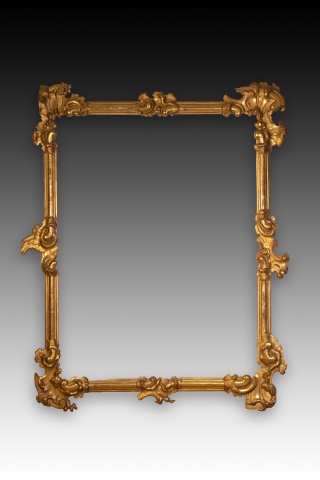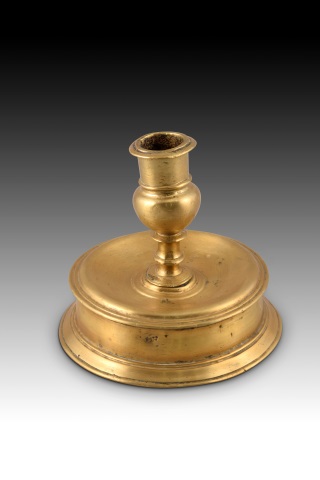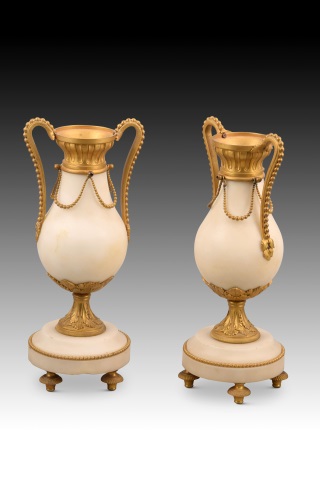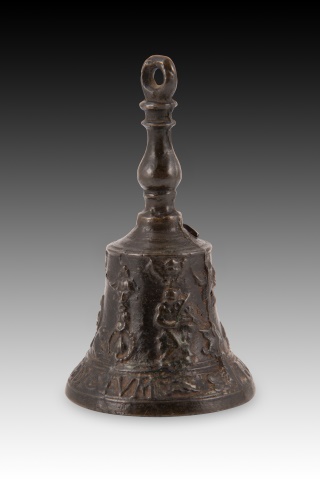
-
Sugar box. Silver in colour. Northern Europe (possibly Berlin), first half of the 19th century. With contrast marks. Rectangular box with chamfered corners resting on four claws with nails and featuring a lid with a projection towards the centre and a plaque with engraved initials of ownership. On the outside, it has a frieze of plant motifs above the keyhole. There is evidence of a sugar box in a private European collection with a hallmark similar to that of this piece (the initial A in a circle), being a neoclassical work from Berlin, the work of Gottlob Ludwig Howalt, and dated around 1820. This type of sugar bowls with closure were common in certain areas of northern Europe, taking on an appearance similar to that of this piece following the invasion of Napoleon Bonaparte, with which the French aesthetic models spread. Weight: 487 grams.
· Size: 16x12x10 cms.
ANTIQUES
MISCELLANEUS;SILVER
Ref.: ZF1319
-
Sold

Rococo frame. Gilt wood. 18th century. Rectangular frame made of carved and gilded wood, decorated at the corners and centers of the sides with carvings depicting architectural elements, plants, and rocailles. The contrast between the plain moldings of the uncarved sections and the carvings, the absence of a crest, and the asymmetry present in the piece are striking. The latter was common in the early Rococo period, an artistic style born in France and developing primarily between 1730 and around 1760.
· Size: 100x3x121,5 cms. Int 76x99,5 cms
ANTIQUES
MISCELLANEUS;FRAMES
Ref.: ZF1336
-
Plan, Fondazione Querini Stampalia. Framed drawing. SCARPA, Carlo (1906-1978), 1978. Signed and dated (bottom left), name in the center. Plan of Carlo Scarpa's intervention at the Fondazione Querini Stampalia, a cultural institution in Venice, Italy, founded in 1869 by Count Guiovanni Querini, the last descendant of the Querini Stampalia family. Carlo Scarpa designed the interior, exterior, and elements of the garden and ground-floor spaces of the historic building (Palazzo Querini Stampalia).
· Size: 47x4x65,5 cms
ANTIQUES
MISCELLANEUS;GRAPHIC WORK
Ref.: ZF135448
-
Pair of wrought iron fork locks. 17th century. Pair of forged iron fasteners of the so-called “fork” type due to their shape. This type of piece was used in furniture to secure tables, both dining tables and those in writing desks and bureaus, and for this reason it is a very common piece of forged iron. The spirals and the balustrade parts date both to the Baroque period.
· Size: 93x25 cms
ANTIQUES
MISCELLANEUS;OTHER OBJECTS
Ref.: Z6419B
-
Sold

Reel candlestick. Bronze. 16th century. A candlestick of the type known as "reel" due to the shape of its base, made of bronze in its color. This type can already be found in Spanish Gothic pieces and has remained very common ever since. Over the following centuries, details such as the proportions of the base, its lines, and the top finial would be varied, adapting it to suit the taste of the moment.
· Size: 13.5x13.5x13 cms
ANTIQUES
MISCELLANEUS;OTHER OBJECTS
Ref.: ZE315
-
Seven mustache makers with spoons. Silver, glass. England, 20th century. With contrast marks. Silver plated cutlery with glass elements inside and hallmarked: Henry Hobson & Sons., Birmingham, 1900; possibly E Druiff & Co., established 1919, Birmingham, possibly 1924; etc. They feature spoons, as is typical of this type, and are stylistically inspired by trends common in 19th century English silverware. Weight 530 grams.
· Size: 7,4x5x6 cms
ANTIQUES
MISCELLANEUS;SILVER
Ref.: ZF1373
-
Bow brooch. Silver, rhinestone. Around the first third of the 20th century. With partial hallmark. Bow-shaped brooch made of silver in its colour with a needle on the back and a composition on the front combining white stones and lines of fine red stones, enhancing the shape and lines of the piece. It is similar to brooches by the firm Collingwood and Sons (Birmingham, England). It has a small partial hallmark on the prong.
· Size: 4x1x2,5 cms
ANTIQUES
MISCELLANEUS;JEWELRY
Ref.: Z4997
-
Chocolate cutter. Wood, metal. 19th century. Chocolate chopper made of carved wood decorated with engraved plant and floral motifs, featuring an iron blade in the shape of a small horse, which has a turned wooden handle. Compare with the one from Salamanca preserved in the CIPE Costume Museum in Madrid (inventory CE008848) dating from the 19th century.
· Size: 44x17x13 cms.
ANTIQUES
MISCELLANEUS;OTHER OBJECTS
Ref.: ZE441
-
Peace-bearer. Bronze. 16th century. Peace-holder made of bronze with a flat handle on the back and a slightly raised decoration on the front. Beneath a crown of openwork plant elements in a clear Renaissance style, there is an architectural composition with columns framing a figure of Christ sitting on a throne.
· Size: 7,5x3x10,5 cms
ANTIQUES
MISCELLANEUS;OTHER OBJECTS
Ref.: ZF0538
-
Peace-bearer. Bronze. 16th century. Bronze peace-bearer with a flat “C” handle on the back, with a relief decoration on the front framed in a classical architectural composition common in the Renaissance. Below the columns on the sides there are two heraldic shields (without a bonnet, cords with tassels on three levels) with a Latin cross in the middle area; the centre shows a Birth of Christ under a domed cupola with winged angel heads in the corners; at the top and under a semicircular arch, there is the bust of Santo Domingo de la Calzada, facing forward, with an inscription in capital letters.
· Size: 10,5x5x15,5 cms.
ANTIQUES
MISCELLANEUS;OTHER OBJECTS
Ref.: ZF0543A
-
Sold

Pair of vases. Bronze, marble. 19th century. Pair of vases made of carved light marble with a stepped, circular base of the same material. They also feature decorative details in gilt bronze (pearl chains, necks with architectural elements, etc.), clearly showing a classicist influence. This type of work was common in Europe during the 19th century, and the strong French influence was also very common.
· Size: 10,5x10,5x27,5 cms.
ANTIQUES
MISCELLANEUS;OTHER OBJECTS
Ref.: ZF1004
-
Inkwell. Glazed ceramic. Talavera de la Reina, Spain, 17th century. A square-shaped inkwell or spice rack made of glazed ceramic with a polychrome decoration of plant elements on the top and fronts. Due to the colours used, it belongs to the so-called tricolour series, which began to be produced in Talavera de la Reina at the beginning of the 16th century and became common even at the beginning of the 18th century. Compare this with the decorations on pieces kept in the Museo Nacional de Artes Decorativas (Madrid, Spain), or in the Museo de Cerámica Ruiz de Luna in Talavera de la Reina (Toledo, Spain).
· Size: 9x9x5.5 cms
ANTIQUES
MISCELLANEUS;CERAMIC
Ref.: ZF1047
-

Hand bell or bell, “from Malinas”. Bronze. 16th century. Hand bell with clapper made of bronze and decorated on the outside with a slight relief. The base has, between bands, an inscription in capital letters and in Latin (“Sit nomen Domini benedictum”, “Blessed be the name of the Lord!”); above it, on the body of the bell, there is a decoration with angels, vases with plant elements, garlands, a figure playing a musical instrument, etc., with a great classical influence; the hand has a balustrade shape with mouldings. The text refers to the Apostolic or Papal Blessing, typical of Catholic liturgy. The export trade of handicrafts and artistic pieces during the 15th and 16th centuries that took place in the Netherlands was of great importance, especially between the territories that were then united under the same crown. Among the pieces (experts speak of almost industrial production) that enjoyed the greatest diffusion were these bells called "de Malinas" because they came from this Flemish city. The success of the model is indisputable and proof of this is that, from imported examples, molds were made with which to obtain absolutely identical copies. These bells usually have common characteristics such as their small size and their beveled profile; however, the peculiarity that easily identifies them is the decoration they have on their surface. Weight: 425 grams.
· Size: 8x8x14 cms.
ANTIQUES
MISCELLANEUS;OTHER OBJECTS
Ref.: ZF1302
-
"Poster announcing the Bullfight held on the occasion of the marriage of HM King Alfonso XIII to HRH Princess Victoria Eugenie of Battenberg." Framed lithograph. BENLLIURE, Mariano. Spain, 1906. Alfonso XIII can be seen greeting the public from the royal box, accompanied by Victoria Eugenia and a number of figures, below the text, which extends to the right. In the lower area, with ribbons, you can read "Long Live the Queen." The model for this poster was designed by Mariano Benlliure (1862-1947), who already had experience as a bullfighting poster artist. The lithographic artist was Antonio de Ángel Alcoy (circa 1863-1925), and the Litografía Mateu of Madrid was responsible for the production.
· Size: 47x1x68 cms
ANTIQUES
MISCELLANEUS;GRAPHIC WORK
Ref.: ZF135445
-
Vegetable bowl with lid, Morro Castle, Havana, Cuba. Earthenware. Sargadelos, 19th century. It has minor flaws. Vegetable bowl with handles and a lid on which a landscape can be seen, identified with a text (Morro Castle, Havana, Cuba), enhanced by a border that extends over the edge and continues (but in relief, not in pigmentation) along the handles of the piece; the base also has decoration. The lid has a flower in relief as a finish and a series of decorative borders in a tone matching the rest of the piece. Antonio Raimundo Ibáñez, Marquis of Sargadelos, founded the Royal Pottery Factory of Sargadelos in Cervo, province of Lugo, at the beginning of the 19th century. The view of this piece belongs to the Series of Views of Cuba, used in the factory since 1848.
· Size: 34x26x18 cms
ANTIQUES
MISCELLANEUS;CERAMIC
Ref.: ZF1370A
-
Oinochoe. Bronze. Possibly Italy, 19th century. An oenochoe, oinochoe, oinochoe or oenochoe is a vessel used to draw wine from a krater (where it was stored) before serving in ancient Greece. Its heyday was during the Geometric period and various types are distinguished according to the shape of the mouth and the belly. Most Greek oenochoes were made of terracotta, but there are also some made of precious metals, presumably for the social classes that could afford them, although very few have survived. The present example seems to be inspired by ancient works (compare one in the Metropolitan Museum from around 460 BC with inventory number 1970.11.1 and another in the Museum of Fine Arts, Budapest with inventory number 66.142.A).
· Size: 12x12x20 cms
ANTIQUES
MISCELLANEUS;OTHER OBJECTS
Ref.: ZF1390
-
Pair of vases. Bronze. Japan, Meiji period (1868-1912). Pair of bronze vases decorated with figurative elements and a band of gadroons. The necks feature two oriental-style dragons in flight, while the bodies depict birds, branches, and fruit in various poses. Stylistically, they are similar to examples in private collections dating to the late 19th century. Weight: 5.45 kg.
· Size: 19x19x32 cms
ANTIQUES
MISCELLANEUS;OTHER OBJECTS
Ref.: ZF1439
-
Door knocker. Wrought iron. 16th century. Door knocker made of wrought iron and made up of several pieces, among which the main one stands out. It has two bands that start in parallel and then separate to form two facing volutes joined in this area by a rectangular piece, also showing several engraved lines that highlight these elements. The use of wrought iron volutes was common since Romanesque times, and we can speak of an evolution in this element over time. The present example belongs, due to its shape, to a type of handle or knocker known as “scissor”.
· Size: 15x8,5x2 cms
ANTIQUES
MISCELLANEUS;OTHER OBJECTS
Ref.: Z0007A
-
Cylindrical “turner’s test” box, 17th-18th century. Cylindrical box decorated with different bands and a lid with a carved star. On the base there are a series of inscriptions that allude to the purpose for which it was created: these types of pieces were tests of mastery for apprentice turners, which they had to take in order to pass certain exams within the guild to which they belonged. Many of these works are not preserved because they are more practical than decorative and not commissioned by a client, but their interest is undeniable for this very reason.
· Size: 10,5x10,5x19 cms.
ANTIQUES
MISCELLANEUS;OTHER OBJECTS
Ref.: Z2330
-
Espagnolette. Wrought iron. 18th century. An iron element made up of several pieces firmly joined together, with simple decoration based on rings and other details, used to close a door or window. This type of piece was very common in the construction of important residences. 2 pcs available.
· Size: Longitud 205 cms.
ANTIQUES
MISCELLANEUS;OTHER OBJECTS
Ref.: Z3485B
-
Mother-of-pearl box with bronze mount. 19th century. Box made of mother-of-pearl plates joined together by a bronze structure decorated with simple plant elements and which still retains traces of gilding in some areas. The shape of the piece is reminiscent of examples inspired by the French Louis XV style, while the materials used were common in the decorative arts of the 19th century.
· Size: 7,5x5,5x4 cms.
ANTIQUES
MISCELLANEUS;OTHER OBJECTS
Ref.: Z3817
-
“Catavinos” or bernegal. Silver. 20th century. Vessel of the type known as “tembladera” with two circular handles decorated with very simplified plant elements and a scalloped body reminiscent of the pieces called “de bocados”. Bernegales and tembladeras de bocados were frequent pieces in Spanish silverware in the 17th century, usually being relegated to centres of somewhat less importance in the 18th century. During the 19th and 20th centuries, it was common in silverware and the rest of the arts to be inspired by styles of the past for the creation of numerous pieces, such as this one. Weight: 151 gr.
· Size: 15x11,5x7,5 cms.
ANTIQUES
MISCELLANEUS;SILVER
Ref.: Z5830
-
Acetre. Bronze. 16th century. Bronze piece with a circular base and a circular body with a mouth that extends outwards at the top and a relief decoration in this last area with masks that recall certain Renaissance pieces with Medusa (the rings for the handle emerge from two of these elements). This acetre, a vessel for holy water also known as a situla, is a piece that, in this religious context, appeared in the West in the Middle Ages. The present example is inspired by Renaissance pieces both in its lines and its decoration and, therefore, is also reminiscent of works from Ancient Rome (situla from the Landesmuseum in Hannover, etc.).
· Size: 19x18x19 cms.
ANTIQUES
MISCELLANEUS;OTHER OBJECTS
Ref.: Z5937
-
Chocolate cutter. Wood, metal. 19th century. Chocolate chopper made of carved wood with an iron blade in the shape of a horse, which has a turned wooden handle. Compare with the one from Salamanca preserved in the CIPE Costume Museum in Madrid (inventory CE008848) dating from the 19th century.
· Size: 32x32,5x11 cms.
ANTIQUES
MISCELLANEUS;OTHER OBJECTS
Ref.: ZE442